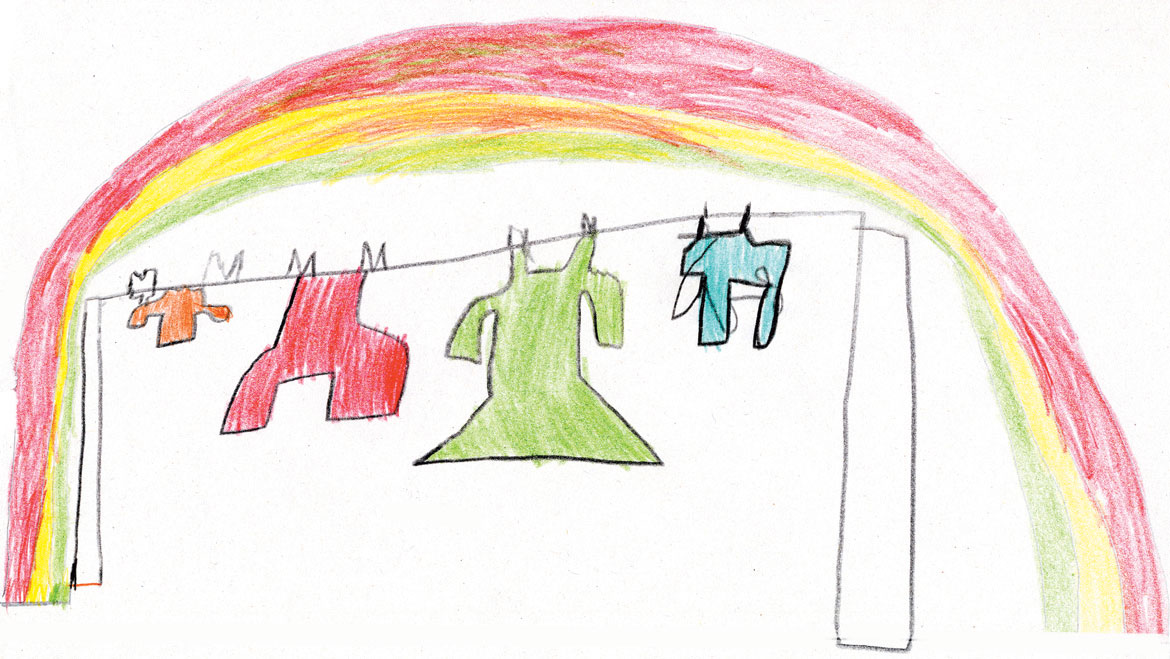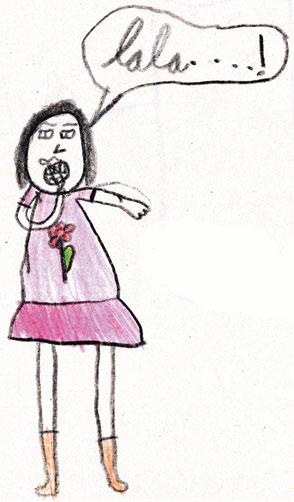 |
|
Theatre Foyer Gallery
November 13, 2005 - January 2, 2006
|
 |
Drawing The Remarkable Maria: Crayons Across the Americas
Tara Langlois & Patti McIntosh
|
| Official Web Site |
 |
 |
 |
 |
 |
 |
Q + A with Tara Langlois & Patti McIntosh
Illustrator and Writer, The Remarkable Maria
|
- What was the inspiration for The Remarkable Maria?
Patti: I was first in Paramaribo, Suriname in 2004, working on a capacity development project with five ASO's [AIDS Service Organizations]. These organizations are quite small, very grassroots – and, by and large, very front line: especially the groups that are working with children “infected or affected” by HIV/AIDS.
I'd be having meetings with these ASO's and the kids would be running around the house, or wanting to sit on your lap, wanting to play with the pen you were writing with, and so on. So, I think, when these organizations are speaking to you of their organizational or financial challenges and their “client group” is sitting on your lap – it becomes a very real experience.
On the analytical, organizational, financial side of things, it is estimated that the housing needs for children will grow 10 fold in the next five years. Ten-fold! On the social side of things, there were incidents in the newspapers where parents were complaining about having children from one of the ASO's in school.
These things were building in my mind. But the catalyst for the project came when I visited one of the ASO's on the first day of school and one of the young girls had been sent home from school because she had an open cold sore on her face. The girl was remarkable. She was still wearing her school uniform – and she was carrying herself with an amazing dignity; hanging out with the adults, waiting for the others to come home.
The meeting that girl was the catalyst for everything. She seemed representative of many children affected by this disease – faced with isolation, discrimination. I thought it was an experience – to meet a child affected -- that I thought was important and, in as much as I could, I wanted people, both children and adults, to have the same experience – to meet a child infected or affected by HIV/AIDS. And so, I started to write the story that became The Remarkable Maria.
- You worked with children in Suriname on illustration the book. Talk about that process and how it influenced the illustration of the book.
Tara: The kids were instrumental in how the final illustrations turned out. My imagination is limited by my individual experiences and perceptions of the world, so how could I possibly visualize Maria's story from my kitchen table back in Canada?
We started the workshops by talking to them about HIV/AIDS, issues of discrimination and, over the course of the four evenings, read them Maria's story. We asked them to show us (through drawing) what Maria's experiences would have looked like. What games would they exclude Maria from? (playing ball) What would Maria be wearing? (a skirt) What would her environment look like? (palm trees and dirt roads with random sprouts of grass)
I found a couple things very interesting:
- many images were simplistic compositions or lacked details in the context and, whether intentional or not, reinforced the idea of isolation
- the presence of a sun, rainbow or flowers signified happy moments in Maria's life
- There are several influences found in the story: Nelson Mandela, Gandhi, and Bob Marley. How did their thinking affect the development of a children's story?
Patti: They provided the beginning, the middle, and the end of the story. The opening of the story owes a great deal to the opening of Nelson Mandela's autobiography where he tells the history of his name. It an interesting approach: it is amazing how much information is given just talking why you are called what you are. I borrowed it as a trick which allows Maria to set up the story in about 20 words – just by talking about her name.
Bob Marley is huge in Suriname. You see images of him everywhere. So, I borrowed from another icon. No Woman, No Cry is him, in a situation of poverty and desolation, comforting a woman, telling her everything is going to be alright. This comforting optimism would resonate for Maria – and, I think, express her hope to other girls and women listening. In my mind, this is what Maria is singing. (I guess that is a bit of trivia. In the book leaves what Maria is singing to the reader's imagination.)
In the middle of the story, the wisdom of Gandhi -- not letting people walk through your mind with their dirty feet - is tremendously relevant to what Maria is experiencing. I liked the idea of including "adult" advice to a child that makes absolutely no literal sense. But you know what it means. And there is a statue of Gandhi in Paramaribo so in that way children may be familiar with him.
The age range for the book is great; I hope it can be read on different levels. When we first shared it in Paramaribo, the very young children understood the story on their level: discrimination means others won't play with you. And that makes you cry.
- Both words and pictures speak strongly in The Remarkable Maria. How did you - as artist and author - work out a form of collaboration that you felt comfortable with?
Tara: It started with a draft of Patti's amazing story, lots of discussion and many, many sketches. The challenge, of course, is for the images and the text to complement and add meaning to each other rather than simply duplicate each other. We decided what aspects of the story were communicated better through words vs. images and edited accordingly. For example, a facial expression can be more effective than describing an emotion through words. And, the complexity of Maria's domestic situation cannot be captured in a single image.
Patti and I talked at length about the characters too. Each of them is inspired by actual people Patti met on her initial visit to Suriname. By the time we went down there in June I had a strong sense of what they should look like and what types of personalities they would have. As I met some of these individuals myself, they (as well as others) continued to influence my ideas – a little homage to the people who had an impact on us.
- Can we expect a sequel?
Patti: Maybe! We've talked about having Maria attend the World Economic Forum in Davos, visit a real-life friend who is with Médicins Sans Frontières in Africa, visit her cousin in the Interior of Suriname -- and come to Canada and have supper with Paul Martin. (That is starting to sound like "Where in the World" is Maria?) But we hope so. We are both optimistic Maria will have a long, happy life -- filled with many experiences and many adventures.
About the Illustrator and Writer
Tara Langlois and Patti McIntosh live, work, draw and write mostly in Edmonton, Canada, 7448 kilometres from Paramaribo, Suriname -- as the crow flies.
|
|
|